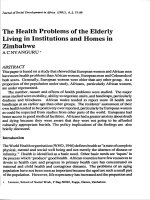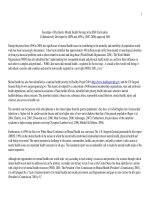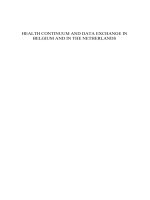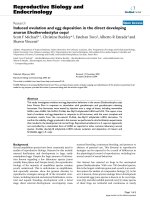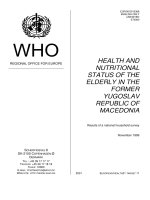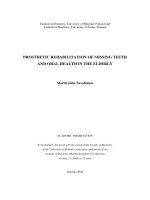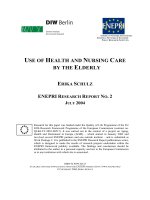Inappropriate Medication Use and Health Outcomes in the Elderly docx
Bạn đang xem bản rút gọn của tài liệu. Xem và tải ngay bản đầy đủ của tài liệu tại đây (86.24 KB, 6 trang )
DRUGS AND PHARMACOLOGY
Inappropriate Medication Use and Health Outcomes in the Elderly
Alex Z. Fu, MS, Gordon G. Liu, PhD, and Dale B. Christensen, PhD
Inappropriate medication use is a major problem for the
elderly. Although increasing attention has been paid to in-
appropriate prescription medication use, most previous re-
search has been limited to the investigation of prevalence and
trends. Few studies provide the empirical evidence for the
adverse effect of inappropriate medication use on health
outcomes at the national level. This study is the first attempt
to assess the relationship between inappropriate prescription
use and health status for the elderly in the United States.
Based on the 1996 Medical Expenditure Panel Survey,
inappropriate medication use in a national representative
elderly population was first identified using Beers criteria. A
survey type of ordered probit model was then estimated to
quantify the effect of inappropriate drug use on patient self-
perceived health status measured using a five-point scale
(poor, fair, good, very good, and excellent). After control-
ling for a set of possible confounding factors, it was found
that individuals using inappropriate medications in Round
1 were more likely than those not using inappropriate med-
ications to report poorer health status in Round 2. Other
risk factors for poor health status include a higher number
of prescriptions, being black, having low education, and
having one or more chronic diseases.
This study provides strong evidence of a significant
adverse effect of inappropriate medication use on patient
health status. These findings lend partial support to the use
of Beers criteria in assessing the quality of prescribing and
the appropriateness of medication use in the elderly pop-
ulation. J Am Geriatr Soc 52:1934–1939, 2004.
Key words: inappropriate prescribing; Beers criteria;
MEPS; health status; ordere d probit model
P
revious studies have suggested that inappropriate pre-
scription drug use is a principal cause of adverse drug
events (ADEs).
1–4
ADEs can lead to additional physician
visits, hospitalizations, injury, deterioration of body func-
tioning, and death.
5–9
The Food and Drug Administration
has estimated that the cost of hospitalizations due to inap-
propriate prescription drug use averages $20 billion annu-
ally.
10
Inappropriateness of drug therapy is a significant
issue for the elderly, because persons aged 65 and older take
many more medications than younger groups. The elderly
constitute approximately 13% of the population but con-
sume 32% of all prescription drugs in the United States.
5,11
Therefore, older persons are at increased risk for inappro-
priate prescription drug use and ADEs. A study in 2001
reported that more than one-fifth of the community-dwell-
ing elderly in the United States received some inappropriate
medication in 1996.
12
Inappropriate medication can be defined as drugs that
pose more risks than benefits to the patients.
13,14
The risk of
using these medications range from minor weakness, to or-
thostatic hypotension, prolonged sedation, falls and frac-
tures, or even life-threatening events.
14
Although attention
has been increasingly paid to medical errors in general, it
has been a challenge for researchers to quantitatively meas-
ure inappropriateness of a drug for different population
cohorts in different settings. In 1991, Beers et al.
13
devel-
oped the first set of explicit criteria to measure inappropri-
ateness of drugs prescribed for nursing home elderly. In
1997, Beers updated the original criteria by incorporating
new information for existing and new drugs.
14
The Beers
criteria prompted a number of empirical studies to quantify
the scale of the problem. Most of these studies were focused
on the prevalence and risk analyses of inappropriate drug
use in the U.S. elderly population.
12,15–17
A few studies also
addressed the associations between inappropriate drug use
and patient health outcome measures.
18–20
However, these
studies were based on local populations or healthcare
settings, which limited the generalizability of their study
results. Moreover, potential confounding factors and cross-
sectional study designs that could be problematic in
attempting to establish a causal relationship between inap-
propriate drug use and changes in health outcome limited
some of these studies.
19
Otherwise, existing literature offers little evidence of
how inappropriate drug use would affect patient health
outcomes, especially at the national level, a critical yard-
stick to fully understand the problem and ultimately to call
for appropriate policy actions. In response, the present
This study was supported in part by a grant from the National Institute on
Aging (R03 AG19876-01). The opinions expressed are solely those of the
authors.
Address correspondence to Gordon G. Liu, PhD, Associate Professor,
Division of Pharmaceutical Policy and Evaluative Sciences, University of
North Carolina at Chapel Hill, School of Pharmacy, Beard Hall, CB #7360,
Chapel Hill, NC 27599. E-mail:
From the Division of Pharmaceutical Policy and Evaluative Sciences,
University of North Carolina at Chapel Hill, Chapel Hill, North Carolina.
JAGS 52:1934–1939, 2004
r 2004 by the American Geriatrics Society
0002-8614/04/$15.00
study is intended to help fill the gap by quantifying the
possible adverse effect of inappropriate drug use on patient
perceived health outcomes by estimating a set of health
status models in relation to inappropriate drug use in the
elderly using the national Medical Expenditure Panel Sur-
vey (MEPS).
METHODS
Data Source
Data were extracted from the 1996 MEPS data set, which
provides nationally representative estimates of healthcare
utilization, expenditures, sources of payment, and insur-
ance coverage for the noninstitutionalized population.
MEPS, maintained by the Agency for Healthcare Research
and Quality, uses an overlapping panel design in which data
are collected through preliminary contact followed by a
series of five rounds of interviews per panel with a time lag
of 4 to 5 months for about 2 years.
This study used the Round 1 and 2 information within
the household component of the 1996 MEPS, initially re-
leased in 2000. This data set contains records for 22,601
persons, including a person-level weight variable that al-
lows making estimates for the noninstitutionalized U.S.
population for 1996. There are also 147,308 prescribed
medicine records in the data set. Each record represents one
household-reported prescribed medicine that was pur-
chased or obtained during 1996, and each record contains
medical conditions associated with the prescribed medicine.
The population studied was people aged 65 and older.
Analytical Approaches
Outcomes Variable
The primary outcomes variable was self-perceived health
status. In MEPS, respondents were asked to rate their health
status compared with other persons of their age as excellent,
very good, good, fair, or poor. This self-assessment ap-
proach has been widely used as a means of gathering in-
formation on health status in epidemiological research and
has proven to have substantial reliability and predictive
validity.
21
Explanatory Variables
In the health outcomes model, the key intervention variable
is whether an individual used any inappropriate prescribed
drugs. Inappropriate drug use was defined as exposure to
any drug on the updated Beers list of 26 drugs or categories
of drugs.
14
Because MEPS lacks information on daily dos-
age or frequency of use for every prescription, only 23 cri-
teria were included in the analysis. Three of the drug
categories (benzodiazepines, digoxin, and iron supple-
ments) were not included in the analysis because they are
only considered inappropriate beyond certain daily dose.
In addition to inappropriate prescription use, three sets
of variables are assumed in the model to affect an individ-
ual’s health status. The first set, referring as predisposing
variables, comprises age, sex, race, education, employment
status, and marital status.
22
The second set comprises enabling variables such as
income, census region, Metropolitan Statistical Areas, and
health insurance. Because the entire sample was eligible for
Medicare, health insurance was categorized into four
groups: Medicare only, Medicare with some private insur-
ance, Medicare with other public insurance including Med-
icaid, and Medicare with private and other public
insurance.
The third set of variables was intended to control for
health conditions that can determine a person’s current
health status. To minimize a possible endogeneity problem
with health conditions in the outcomes model, Round 1
disease condition and functional limitation variables were
used as additional variables to control for preperiod health
status. Based on International Classification of Diseases,
Ninth Revision, Clinical Modification codes, nine chronic
disease conditions were included: heart disease, hyperten-
sion, lung disease, cancer, stroke, diabetes mellitus, more
than one of these diseases, other diseases, and no diseases.
Functional condition variables included help needed in ac-
tivities of daily living, help needed in instrumental activities
of daily living, assistant devices used, limitations in physical
functioning, work/housework/school limitation, social lim-
itations, and cognitive limitations.
Econometric Modeling
Because of the five-scale ordinal nature of the health status
variable, the ordered probit model was employed to esti-
mate the discrete outcome function.
23
A reduced form of
the outcome function can be written as follows:
PrðH
i2
Þ¼Fða þ b Á M
i1
þ d
1
Á N
i1
þ d
2
Á H
i1
þ d
3
Á Z
i2
þ e
i
Þ
where H
i2
is the health status for individual i in Round 2;
M
i1
is a vector indicating the status of inappropriate drug
use for individual i in Round 1; N
i1
represents the total
number of prescription drugs for individual i in Round 1;
H
i1
is a vector consisting of Round 1 health conditions as
need variables, including preexisting health status and
health conditions; Z
i2
is a vector controlling for other ob-
served factors that are in the categories of predisposing and
enabling variables as noted earlier; e
i
is a random error term
to capture all unobserved factors; and F represents the
probit cumulative distribution function.
It is worth noting that the model was specified to in-
clude medication use pattern in Round 1 as a key interven-
tion variable to influence health status in Round 2.
Conceptually, inappropriate use of a drug could have a
short-run and long-run effect on one’s health status. If em-
ploying the Round 2 medication use pattern in the model, a
potential endogeneity problem would occur. This is because
individuals with poor health status may need more medi-
cations and thus became more likely to encounter an inap-
propriate medication, all other factors being equal.
17
Alternatively, the link between drug use in Round 1 and
health status in Round 2 was sought, with a presumption
that one’s medication use pattern in Round 1 and 2 would
be correlated. This presumption was supported by the em-
pirical test results, suggesting a high correlation between the
medication use variables in the two rounds.
In estimating the model, the complex sample design of
MEPS was taken into account, featuring stratification,
clustering, multiple stages of selection, and disproportion-
ate sampling. This results in serious departures from simple
random sampling assumptions. To obtain valid estimates of
INAPPROPRIATE MEDICATION USE AND HEALTH OUTCOMES 1935JAGS NOVEMBER 2004–VOL. 52, NO. 11
the standard errors for the model, the design complexities
were taken into account by specifying the variance estima-
tion strata and the variance estimation primary sample
units in a survey type of ordered probit model.
24
Data cod-
ing and econometric modeling were conducted using SAS
version 8 (SAS Institute, Inc., Cary, NC) and Stata version 6
(Stata Corp., College Station, TX), respectively.
RESULTS
Descriptive Statistics
After excluding observations with missing variables, the fi-
nal sample derived from the 1996 MEPS included 2,305
elderly, representing 30,485,175 elderly nationwide, with
weight adjustment. Of the original sample in Round 1,
there were 537 nonusers of any prescription drugs, 1,462
appropriate medicine users, and 306 inappropriate medi-
cine users. (Number of inappropriate prescriptions ranged
from 1 to 12, with mean 2.2 and median 2.) The most
frequently inappropriately used drugs were propoxyphene
and those containing propoxyphene. In Round 1, the dis-
tribution of perceived health status was excellent, 19.1%;
very good, 25.7%; good, 28.7%; fair, 18.5%; and poor,
8.0%. Similarly, in Round 2, the distribution was excellent,
18.4%; very good, 26.7%; good, 28.0%; fair, 18.7%; and
poor, 8.3%. Chi-square (w
2
) test results confirmed that there
was no difference between the two distributions (w
2
(4) 5 1.036, P 5 .85).
Elderly persons who used inappropriate prescriptions
in Round 1 were more likely than those who did not to
perceive fair or poor health status in Round 2. Chi-square
test indicated that the postperiod health status was signif-
icantly associated with inappropriate prescription drug use
in the preperiod (Po.001).
Modeling Strategies
In an effort to minimize the effect of potential confounding
factors, a sequential modeling strategy was employed by
adding one additional group of explanatory variables at a
time in specifying the models. Model A in Table 1 reports
the ordered probit model results when the equation includ-
ed only prescription drug use. The inappropriate drug use
group had significantly worse health status and the nonuse
group had significantly better health status, both compared
with the group with appropriate drug use.
Models B to D sequentially added in additional control
variables. After including the total number of prescriptions
in Model B, the coefficient of inappropriate drug use de-
creased substantially (from À 0.517 to À 0.330) toward the
null, indicating the strong confounding effect of the total
number of prescriptions taken. Adding predisposing and
enabling variables in Model C, the coefficient remained
virtually the same as before, indicating that these two sets of
variables would not confound or modify the estimates.
However, after adding the need variables in Models D to F,
the coefficient of inappropriate drug use decreased steadily,
strongly suggesting that the need variables would otherwise
bias the estimates upward if not controlled. This is consist-
ent with the hypothesis that no difference in health status
would exist between the elderly with appropriate medica-
tion use and those without any medication use after con-
trolling for preexisting health conditions.
Compared with Model D, Model E replaced the Round
1 health status with health-condition variables. The de-
crease in the coefficient of interest (from À 0.284 to
À 0.235) implies that health condition variables are more
likely to control for the underlying confounding problem
and therefore help minimize the endogeneity. The full
Model F adds in the prior health-status and health-condi-
tion variables. The coefficient of inappropriate prescription
drug use becomes more stabilized at À 0.235 to À 0.234
across the different model specifications, suggesting the
relative robustness and reliability of the full Model F. In
specifying the full model, there was a concern about mul-
ticollinearity within the right-hand side variables in the
model. Accordingly, a pair-wise correlation analysis was
performed, which confirmed that multicollinearity is not a
problem for the study results. Thus the full model results are
reported in the following sections (Table 2).
Explanatory Results
Compared with those with appropriate prescription drug
use, the elderly with inappropriate drug use in Round 1
reported significantly worse health status in Round 2
(Po.01). The total number of prescriptions was strongly
associated with poorer health status (Po.01). As for the
predisposing variables, older blacks had significantly poor-
er health status than whites (Po.05). Elderly with higher
educational degree had better health status than those with
less education (Po.05). Of the enabling variables, none was
found to be predictive of health status, including health
insurance.
As expected, need variables were most highly correlat-
ed with perceived health status. Round 1 health status was
Table 1. Effect of Inappropriate Prescription Use on Health Status
Prescription
Drug Use
Model
ABCDE F
Coefficient Æ Standard Error
Inappropriate À 0.517 Æ 0.082
w
À 0.330 Æ 0.088
w
À 0.347 Æ 0.087
w
À 0.284 Æ 0.083
Ã
À 0.235 Æ 0.087
Ã
À 0.234 Æ 0.084
Ã
No use 0.508 Æ 0.062
w
0.237 Æ 0.068
Ã
0.241 Æ 0.069
Ã
0.103 Æ 0.073 À 0.020 Æ 0.096 À 0.085 Æ 0.097
Note: Appropriate drug use is the reference group. Control variables were total number of prescriptions for Models B, C, D, E, and F; predisposing and enabling
variables for Models C, D, E, and F; self-perceived health status for Models D and F; and health condition variables for Models E and F.
Ã
Po.01;
w
Po.001.
1936 FU ET AL. NOVEMBER 2004–VOL. 52, NO. 11 JAGS
highly predictive of Round 2 health status, with a decreas-
ing trend in magnitude of the coefficients from excellent to
fair, relative to people with poor health status (Po.001).
Likewise, disease condition variables were strongly predic-
tive of health status. Elderly patients with heart disease
(Po.01), hypertension (Po.001), lung disease (Po.05),
diabetes mellitus (Po.001), more than one of the men-
tioned diseases (Po.001), or any other disease conditions
(Po.01) in Round 1 were much more likely to report poor-
er health than those free of any chronic conditions. More-
over, poorer health was shown to be associated with having
limitations in physical (Po.001) and cognitive (Po.01)
function.
The effect of inappropriate drug use on health status
based on the estimated coefficient of À 0.234 in Table 2 will
now be focused on. Because ordered probit model does not
allow a straightforward interpretation of its coefficients as
linear models do, the following simulation procedures were
undertaken. Holding all controlled variables in the model at
their actual value for each individual, the probability of
having each health status was predicted while varying the
dummy value of inappropriate prescription use. These
Table 2. Ordered Probit Model of Health Status for the Elderly
Variable
Ã
Coefficient SE t P-value
Primary interested
Prescription drug use
Inappropriate À 0.234 0.084 À 2.78 .006
No use À 0.085 0.097 À 0.88 .38
Appropriate (Reference)
Total number of prescriptions À 0.013 0.005 À 2.58 .01
Predisposing
Race (reference: white)
Black À 0.238 0.097 À 2.47 .014
Other race
w
0.508 0.213 2.39 .017
Higher degree of education (reference: no
degree)
0.220 0.096 2.28 .023
Need
Self-perceived health status (reference: poor)
Excellent 2.861 0.172 16.62 o.001
Very good 2.046 0.137 14.97 o.001
Good 1.455 0.126 11.52 o.001
Fair 0.881 0.125 7.05 o.001
Disease condition (reference: no disease condition)
Heart disease À 0.490 0.161 À 3.05 .002
Hypertension À 0.406 0.123 À 3.29 .001
Lung disease À0.382 0.168 À 2.27 .02
Diabetes mellitus À 0.454 0.174 À 2.61 .009
More than one of the above disease À 0.607 0.136 À 4.46 o.001
Other diseases except the above À 0.302 0.109 À 2.76 .006
Functional and activity limitations
Limitation in physical functioning À 0.262 0.063 À 4.16 o.001
Cognitive limitations À 0.283 0.104 À 2.72 .007
Note: The model was estimated using the 1996 MEPS data with 135 strata, 537 clusters, 2,305 of observations, and the sum of national weights equal to 30,485,175.
Ã
Only variables (variable groups) with significant coefficients are listed. Variables included in the model but excluded from the table include age, sex, general
equivalency diploma, high school, other degree, employment status, marital status, income, census region, metropolitan statistical areas, heal th insurance, stroke,
cancer, activities of daily living help, instrumental activities of daily living help, assistance devices used, work/housework/school limitation, social limitation. Details
about the statistics are available upon request from the authors.
w
American Indian, Aleut, Eskimo, Asian or Paci fic Islander.
Table 3. Distribution of Health Status in Round 2 by the Use of Prescriptions in Round 1
Round 1
Round 2 Health Status
Prescription Use
Excellent Very Good Good Fair Poor
Mean Percentage of Population Æ Standard Error
Inappropriate 15.9 Æ 0.50 25.3 Æ 0.38 28.6 Æ 0.32 20.2 Æ 0.40 10.0 Æ 0.46
Appropriate 18.7 Æ 0.52 27.2 Æ 0.36 28.2 Æ 0.32 18.1 Æ 0.40 7.9 Æ 0.40
Difference À 2.8 Æ 0.07 À 1.9 Æ 0.07 0.4 Æ 0.09 2.1 Æ 0.08 2.1 Æ 0.08
INAPPROPRIATE MEDICATION USE AND HEALTH OUTCOMES 1937JAGS NOVEMBER 2004–VOL. 52, NO. 11
probabilities were then averaged over the sample to provide
interpretable results, as in Table 3. Based on these results, if
the cohort of appropriate drug users used some inappro-
priate prescriptions, 15.9% of the cohort would perceive
health status as excellent and 10% poor. Similarly, if all
inappropriate drug users used appropriate prescriptions,
their perceived health status would be distributed as excel-
lent for 18.7% and poor for 7.9%. This provides sizable
evidence to policy-makers that, keeping other variables
constant, inappropriate drug use would lead to a decrease in
patient health status.
DISCUSSION
Although previous studies suggested a widely believed no-
tion that inappropriate drug use would have adverse effects
on patient health outcomes, especially in the elderly, this
study adds to the literature by providing the first empirical
evidence documenting such an effect for the national elderly
population derived from the 1996 MEPS data. After con-
trolling for a number of confounding factors in the model,
this study found strong evidence of a sizable and consistent
negative effect of inappropriate prescription drug use on
patient health status.
A few other findings are noteworthy. Among the pre-
disposing variables, there was a significant racial disparity
in health status, in that African Americans had poorer
health status than their white counterparts. Previous liter-
ature has suggested that African Americans have higher
rates of heart disease, stroke, most cancers, pneumonia,
influenza, chronic liver disease, and diabetes mellitus than
whites.
25,26
Given these findings, it is not surprising that
this study found a similar pattern of racial disparity in
self-perceived health status. It was also found that higher
education was associated with better health status. This
finding is consistent with the well-known notion that ed-
ucation and health, the two most important elements of
human capital, are mutually enhanced in the household
production process,
27–29
but healthier people tend to invest
more in education in an attempt to recoup more returns
from the investment. Better-educated people in return are
likely to be more productive and efficient in maintaining
health and using healthcare resources.
The model showed little dependence of health status on
enabling variables, including income, insurance type, and
regional settings. It could be the case that none of the var-
iables played a substantial role in determining health status,
but it cannot be excluded that the insignificant relationships
were partly attributed to measurement errors of the vari-
ables in the database. Poor measurement leads to attenu-
ation bias, but it is also possible that patients who were
prescribed inappropriate medications would receive med-
ical care below acceptable standards or quality, which could
negatively affect self-perceived health. This possible effect
could not be controlled for in the model because of data
limitation.
As expected, need variables were the most predictive of
health status outcomes. Round 1 health status was most
highly correlated with Round 2 health status, following a
decreasing trend of the quantitative coefficients from ex-
cellent to fair, but to some extent, this variable is subject to
an endogeneity bias, as discussed earlier. In contrast, health-
condition variables, including chronic disease conditions
and functional activity limitations, were deemed to be more
objective in measuring need for care and less endogenous in
the determination of self-perceived health status. Other un-
observables associated with the preperiod health status in
the error term could potentially bias the estimate, but a
consistent set of coefficients was obtained across all the
model specifications to indicate the strong effect of a chron-
ic condition on self-perceived health status. Therefore, the
potential bias due to unobservables does not seem to be a
major concern. Although it is difficult to fully eliminate the
estimation bias, the sequential modeling strategy seemed to
help reach the robustness of the estimates as the coefficient
of inappropriate drug use converges to a stable value.
In addition, MEPS does not provide information on
daily dosage or frequency of use for every prescription. As a
result, some drugs had to be excluded from the model be-
cause of conditional inappropriateness. In particular, ben-
zodiazepines, digoxin, and iron supplements were not
included in the analysis because they would be inappropri-
ate only when their dosage exceeded a certain amount. This
limitation would lead to the underestimation of the pop-
ulation size of inappropriate prescription drug use, but be-
cause of the low severity of violating these criteria, the
expected outcome may not be sensitive to such limitation.
14
CONCLUSION
This study is the first empirical research on inappropriate
prescription drug use and health outcomes in the elderly
based on a nationally representative population sample.
Strong evidence was obtained indicating that inappropriate
drug use is associated with subsequent decrease in self-per-
ceived health status in the elderly. These results lend partial
support to the Beers criteria as valid proxy indicators of
poor prescribing practices leading to deterioration of health
status. Owing to the national representation design of
MEPS, the results can be generalized to the national elderly
population in the United States. Previous research suggested
that inappropriate drug use would cause an increased use of
healthcare resources. The current study provides an impor-
tant addition to the literature suggesting that inappropriate
drug use also can have sizable adverse effects on patient
health outcomes. Together, these studies suggest that inap-
propriate prescription drug use can be costly in healthcare
resources and health outcomes. Future research can be di-
rected to better address why and how inappropriate med-
ication use can lead to poor outcomes. With such important
knowledge, better policy actions can be taken to reduce
system medical errors and improve the quality of health
care for the elderly.
30
REFERENCES
1. Lindley CM, Tully MP, Paramsothy V et al. Inappropriate medication is a
major cause of adverse drug reactions in elderly patients. Age Ageing
1992;21:294–300.
2. Bates DW. Frequency, consequences and prevention of adverse drug events.
J Qual Clin Prac 1999;19:13–17.
3. Bates DW, Cullen DJ, Laird N et al. Incidence of adverse drug events and
potential adverse drug events: Implications for prevention. ADE Prevention
Study Group. JAMA 1995;274:29–34.
4. Bates DW, Leape LL, Petrycki S. Incidence and preventability of adverse drug
events in hospitalized adults. J Gen Intern Med 1993;8:289–294.
1938 FU ET AL. NOVEMBER 2004–VOL. 52, NO. 11 JAGS
5. Chrischilles EA, Foley DJ, Wallace RB et al. Use of medications by persons 65
and over: Data from the established populations for epidemiologic studies of
the elderly. J Gerontol 1992;47:M137–M144.
6. Johnson JA, Bootman JL. Drug-related morbidity and mortality and the
economic impact of pharmaceutical care. Am J Health Syst Pharm 1997;54:
554–558.
7. Ray WA, Fought RL, Decker MD. Psychoacti ve drugs and the risk of injurious
motor vehicle crashes in elderly drivers. Am J Epidemiol 1992;136:873–883.
8. Col N, Fanale JE, Kronholm P. The role of medication noncompliance and
adverse drug reactions in hospitalizations of the elderly. Arch Intern Med
1990;150:841–845.
9. Phillips DP, Christenfeld N, Glynn LM. Increase in US medication-error deaths
between 1983 and 1993. Lancet 1998;351:643–644.
10. Prescription Drugs and the ElderlyFMany Still Receive Potentially Harmful
Drugs Despite Recent Improvements (Report no. GAO/HEHS-95–152).
Washington, DC: U.S. General Accounting Office, 1995.
11. Soumerai SB, Ross-Degnan D. Inadequate prescription-drug coverage for
Medicare enrolleesFa call to action. N Engl J Med 1999;340:722–728.
12. Zhan C. Potentially inappropriate medication use in the community-dwelling
elderly: Findings from the 1996 Medical Expenditure Panel Survey. JAMA
2001;286:2823–2829.
13. Beers MH, Ouslander JG, Rollingher I et al. Explicit criteria for determining
inappropriate medication use in nursing home residents: UCLA Division of
Geriatric Medicine. Arch Intern Med 1991;151:1825–1832.
14. Beers MH. Explicit criteria for determining potentially inappropriate medi-
cation use by the elderly: An update. Arch Intern Med 1997;157:1531–1536.
15. Willcox SM, Himmelstein DU, Woolhandler S. Inappropriate drug prescribing
for the community-dwelling elderly. JAMA 1994;272:292–296.
16. Golden AG, Preston RA, Barnett SD et al. Inappropriate medication prescrib-
ing in homebound older adults. J Am Geriatr Soc 1999;47:948–953.
17. Liu GG, Christensen DB. The continued challenge of inappropriate prescribing
in the elderly: An update of the evidence. J Am Pharm Assoc 2002;42:847–
857.
18. Chin MH, Wang LC, Jin L et al. Appropriateness of medication selection for
older persons in an urban academic emergency department. Acad Emerg Med
1999;6:1232–1242.
19. Fick DM, Waller JL, Maclean JR et al. Potentially inappropriate medication
use in a Medicare managed care population: Association with higher costs and
utilization. J Manag Care Pharm 2001;7:407–413.
20. Hanlon JT. Impact of inappropriate drug use on mortality and functional
status in representative community dwelling elders. Med Care 2002;40:
166–176.
21. LaVange LM, Silverman HA. Outpatient prescription drug utilization and
expenditure patterns of noninstitutionalized aged Medicare beneficiaries. Natl
Med Care Util Expend Surv B 1987;April:1–43.
22. Aday LA, Andersen R. A framework for the study of access to medical care.
Health Serv Res 1974;9:208–220.
23. Greene WH. Econometric Analysis. Upper Saddle River, NJ: Prentice-Hall
Inc., 2000.
24. Lohr SL. Sampling. Design and Analysis. Pacific Grove: CA: Duxbury Press,
1999.
25. Pamuk E, Makuc D, Heck K et al. Health, United States 1998: Socioeconomic
Status and Health Chartbook (DHHS no. 98–1232). Hyattsville, MD: Na-
tional Center for Health Statistics, 1998.
26. Winkleby MA, Robinson TN, Sundquist J et al. Ethnic variation in cardio-
vascular disease risk factors among children and young adults: Findings from
the Third National Health and Nutrition Examination Survey, 1988–94.
JAMA 1999;281:1006–1013.
27. Grossman M. On the concept of health capital and the demand for health.
J Political Econ 1972;80:223–255.
28. Schultz TP. Health and schooling investments in Africa. J Econ Perspect 1999;
13:67–88.
29. Bloom DE, Canning D. The health and wealth of nations. Science 2000;287:
1207–1209.
30. Institute of Medicine. To Err Is Human: Building a Safer Health System.
Washington, DC: National Academic Press, 2000.
INAPPROPRIATE MEDICATION USE AND HEALTH OUTCOMES 1939JAGS NOVEMBER 2004–VOL. 52, NO. 11


